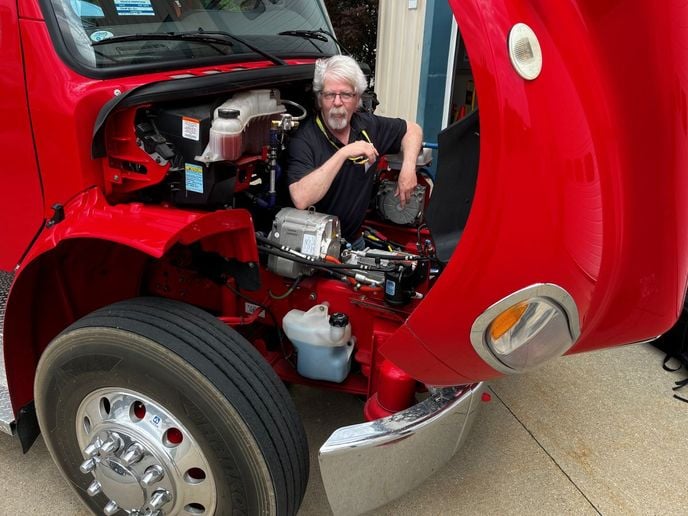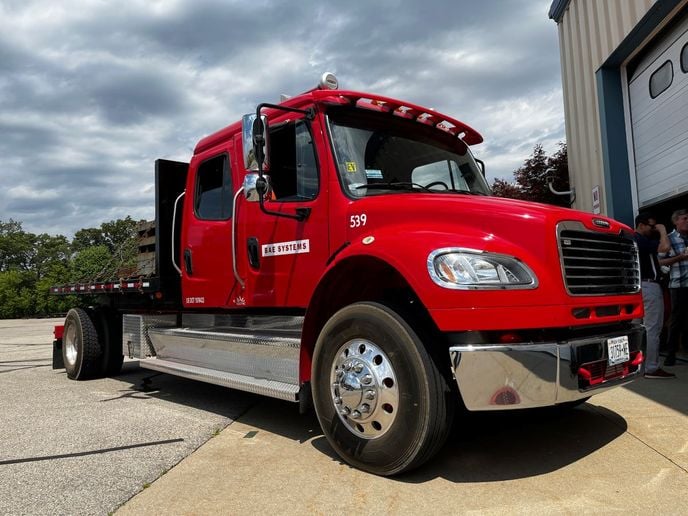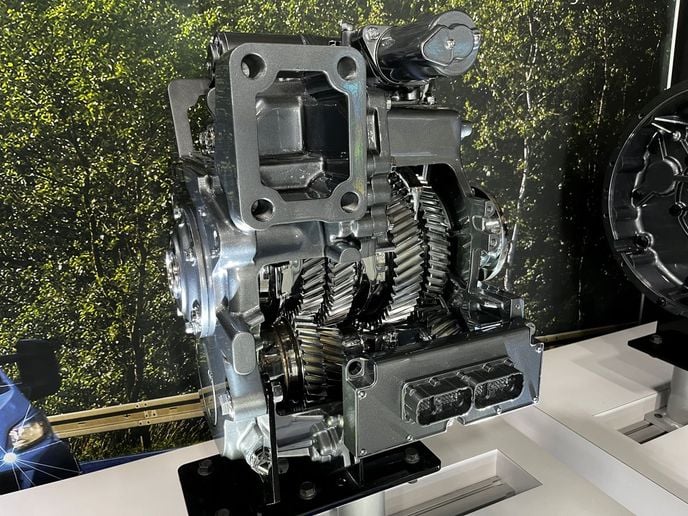Trucker Access › Forums › Diesel News › Eaton, BAE Systems Unveil Lightweight Electronic Powertrain – Fuel Smarts
- This topic has 0 replies, 1 voice, and was last updated 5 months ago by
 EazyRiDer66.
EazyRiDer66.
-
AuthorPosts
-
June 26, 2024 at 2:45 pm #27390
 EazyRiDer66Keymaster
EazyRiDer66Keymaster

A high level of electronic integration and modular design reduces the parts count from 145 to 69, freeing up previously occupied chassis real estate and space under the hood. (the author is standing in the engine compartment between the frame rails with both feet planted firmly on the ground).
BAE Systems isn’t yet a household name in trucking, but it might soon be. The fruits of a collaboration with Eaton are already generating a buzz among original equipment manufacturers and commercial vehicle modifiers.
BAE is best known for its contributions to aerospace engineering: fighter jets, aero-engine controls, the Mars Rover lander, The James B. Webb telescope … And propulsion systems for electric transit buses.
Background in Buses
BAE has been developing electric propulsion systems for buses for over 25 years, and currently powers nearly 18,000 of them across 25 different platforms. Those buses operate in dozens of very challenging markets, including San Francisco, New York City, Boston, Seatle, Paris, and London, among others.
“We’re big, we’re committed to electrification, and we’ve got a lot of experience with 5 billion miles of revenue service on Class 8 electrified vehicles,” said Tom Webb, director of business development and strategy, power and propulsion systems at BAE Systems. “That’s buses, mind you, not trucks, but there are similarities there.”
The value proposition BAE intends to offer through its relationship with Eaton is a highly integrated powertrain at a fraction of the weight and cost of what could be called typical of today’s Class 7 or Class 8 trucks.
Webb said it’s about consolidating and integrating as many of the electric functions currently delivered by six, eight or even 12 separate control units, or “boxes,” into a two-box solution, and eventually into a single controller.
“Our roadmap is to get to a one-box solution by 2027,” Webb said, speaking at a media briefing held in June at Eaton’s proving grounds in Marshall Michigan. “The obvious benefits are weight reduction, bill of material reduction, simplification, lower costs and improved reliability.
“And that brings us to modularity; the ability to separate or add and expand and configure those highly integrated components to match the needs of the vehicle and its duty cycle,” he added. “For the OEM, it means getting to market faster while lowering their non-recurring expenses, particularly if they have wide product portfolio.”
Come 2027, the so-called one-box option will still be offered in a two-box configuration, as it sits today.
Webb said some OEMs may desire some chassis placement flexibility.
Webb noted that integration can yield a weight reduction of about 50% compared to a typical first-generation Class 7 EV chassis while reducing the parts count from 145 to 69. This would include significant reductions in high-voltage cable, connectors, coolant lines and fittings, components and component mounts while freeing up previously occupied chassis real estate and space under the hood.
Eaton’s End of the Bargain
Eaton’s role in this is not insignificant. The company has enjoyed standard-spec placement on heavy and medium trucks for decades. Best known for clutches, manual and automated transmissions, differentials and gearing, and more. Eaton is now expanding its product portfolio into the EV space with power electronics offerings, power distribution, EV gearing, torque control products and automated EV transmissions.

BAE Systems and Eaton unveiled this demonstration truck at the Marshall Proving Grounds in June. It combines BAE’s suite of power dense, advanced power electronics with Eaton’s MD 4-speed EV transmission to provide a full heavy-duty EV system.
Interestingly, Eaton is a significant player in the electrical world, accounting for about two-thirds of the company’s business. This includes everything from a 20-amp circuit breaker you can buy at any hardware store, to vacuum breakers used in medium-voltage electrical distribution substations.
“We offer a host of electrical components, switch gear and panel boards for data centers, etc.,” said Justin Hopkins, Eaton’s product director for EV gearing and transmissions. “We have a ton of experience there gained through the acquisition of companies like Westinghouse, Cutler Hammer, Cooper Bussmann and others over the past four decades or so.
“While that technology is from the Industrial side of Eaton, some of it will translate to the fleet side with charging solutions that will complement our on-vehicle powertrain solutions,” he added.
Presently, Eaton’s role in the EV space is limited to Thomas Built school buses, for which it provides a two-speed medium-duty transmission, and a soon-to-expire agreement with bankrupt transit bus maker, Proterra.
Eaton also provided the medium-duty four-speed transmission for transit bus business.
“We do still have some of that lingering business, but obviously those dynamics changed with their reconfiguration on a bankruptcy,” Hopkins said.
Non-Exclusive Co-Marketing Agreement
Eaton’s strategic decision to not get into the electric motor space left a nice opening for this collaboration with BAE Systems. Eaton does not have the commercial vehicle inverters and the rest of the accessory power electronics that BAE does, and BAE is better served with proven application-tailored transmission.
“It made sense to work together because we do have such complementary portfolios, even though we’re both involved in the segments with different technologies,” Hopkins said. “EV transmissions was kind of a natural fit. I think both companies realized there are benefits to having a multi-speed transmission in some but not all applications.”

Eaton’s MD 4-speed automated manual EV transmission improves startability and gradability while improving energy efficiency at highway speeds.
The agreement between BAE Systems and Eaton, announced last May, follows the signing of a memorandum of understanding between the two.
The MoU provided a non-exclusive, co-marketing arrangement where each can maintain the share of certain markets but collaborate in area of mutual benefit.
“Eaton continues selling transmissions to OEMs that may have selected a different motor and already partnered with different powertrain providers,” Hopkins explained. “Likewise, BAE can and will continue to sell direct drive systems where there’s no transmission and certainly are going to be open to selling their power electronics and motors to customers who may have a different transmission in mind.”
-
AuthorPosts
- You must be logged in to reply to this topic.